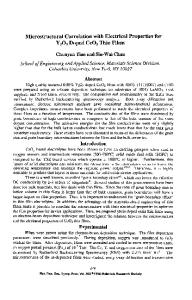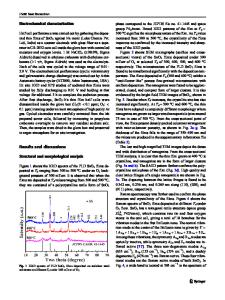Electrochemical Properties of SnO 2 Thin Films Doped with Bi and Si for Negative Electrode of Microbattery
- PDF / 546,260 Bytes
- 5 Pages / 612 x 792 pts (letter) Page_size
- 17 Downloads / 268 Views
Electrochemical Properties of SnO2 Thin Films Doped with Bi and Si for Negative Electrode of Microbattery Young-Il Kim, Hee-Soo Moon, Kwang-Sun Ji, You-Kee Lee* and Jong-Wan Park Division of Materials Science and Engineering, Hanyang University, 17 Haengdang-Dong, Seongdong-Ku, Seoul 133-791, Korea *Department of Semiconductor Engineering, Uiduk University, San 50, Yookum-Ri, Kangdong-Myun, Kyoungju 780-713, Korea ABSTRACT Tin oxide has been proposed as a promising alternative anode material for microbatteries. It has been reported that its theoretical volumetric capacity is four times larger than that of carbonbased materials, while its gravimetric capacity is twice as large. In this experiment, optimal Si and Bi doped SnO2 films were prepared with e-beam evaporation to improve both the cycle performance and the reversible capacity. The films with addition of Si only exhibited reductions in aggregation of tin particles and formation of micro-cracks. However, there still remained cracks, which induce capacity loss during cycling. To improve capacity retention, Bi was added with Si to SnO2 films, which exhibited the highest reversible capacity of 200µAh/cm2-µm at 200th cycle. The films doped with Bi and Si were found to be ill-defined and featureless without noticeable particle aggregation and cracks. However, the films that underwent cycling tests showed again aggregated tin particles and formation of cracks, which would induce cell failure during cycling. We believe that some types of Li-Bi phases as mixed-conductor matrices have improved the cycle life.
INTRODUCTION In recent years, electronic devices have been considerably improved in integration and power consumption but in size of power source has been relatively slow compare with others. Accordingly, miniaturization of electronic devices has been delayed by slow advance in the size of power sources. Thin film rechargeable microbattery, serving as an independent power supply in micromachining and a backup source for electronic circuits, has been given much attentions1. Tin oxide has been proposed as a promising alternative anode material for microbatteries. It has been reported that its theoretical volumetric capacity is four times larger than that of carbonbased material, while its gravimetric capacity is twice as large2. However, tin oxide anodes have a large irreversible capacity resulting from the formation of metallic Sn and Li2O during first cycle in addition to two or threefold volume changes during Li ion insertion and extraction. This process induces cracking and eventual destruction of the anode3. Since Courtney and Dahn reported4 that the main factors, which are responsible for capacity retention for long cycle life, are small alloy grains and small Sn particles themselves and ultra-fine alloy powders such as SiSnO3, Li2SnO3. Specially, in case of Si-SnO2 system, the Si also can form alloy with Li and nano-sized small Si grains can retard volume changes5. In addition, the difference in the values of Gibbs free energies of formation between Li2O (-56
Data Loading...











